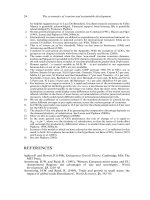THE ECONOMICS OF MONEY,BANKING, AND FINANCIAL MARKETS 385
Bạn đang xem bản rút gọn của tài liệu. Xem và tải ngay bản đầy đủ của tài liệu tại đây (43.85 KB, 1 trang )
CHAPTER 14
Risk Management with Financial Derivatives
Value in March 2011 @ 8% interest rate
Value in March 2010 @ 6% interest rate
Loss
353
$4 039 640
*$5 000 000
*$ 960 360
However, the short position in the 50 futures contracts that obligate you to deliver
$5 million of the 6s of 2030 in March 2011 has a value equal to $4 039 640, the value
of the $5 million of bonds after the interest rate has risen to 8%. Yet when you sold
the futures contract, the buyer was obligated to pay you $5 million on the maturity
date. Thus the gain from the short position on these contracts is also $960 360:
Amount paid to you in March 2011, agreed in March 2010
Cost of bonds delivered in March 2011 @ 8% interest rate
Gain
$5 000 000
*$4 039 640
$ 960 360
Therefore, the net gain for the First Bank is zero, showing that the hedge has been
conducted successfully.
The hedge just described is called a micro hedge because the financial institution is hedging the interest-rate risk for a specific asset it is holding. A second
type of hedge that financial institutions engage in is called a macro hedge, in
which the hedge is for the institution s entire portfolio. For example, if a bank has
more rate-sensitive liabilities than assets, a rise in interest rates will cause the value
of the bank to decline. By selling interest-rate future contracts that will yield a
profit when interest rates rise, the bank can offset the losses on its overall portfolio from an interest-rate rise and thereby hedge its interest-rate risk.
Organization
of Trading in
Financial
Futures
Markets
Financial futures contracts are traded on organized exchanges such as the
Chicago Board of Trade, the Chicago Mercantile Exchange, the Montreal
Exchange, the London International Financial Futures Exchange, and the March
Terme International de France. These futures exchanges are highly competitive
with one another, and each organization tries to design contracts and set rules
that will increase the amount of futures trading on its exchange. The exchanges
are also regulated to ensure that prices in the market are not being manipulated.
The most widely traded financial futures contracts in the U.S. and the exchanges
where they are traded (along with the number of contracts outstanding, called
open interest, in January 2009) are listed in Table 14-1.
Given the globalization of other financial markets in recent years, it is not surprising that increased international competition has been occurring in financial
futures markets as well.
The Globalization of
Financial
Futures
Markets
Because futures exchanges in the United States were the first to develop financial futures, they dominated the trading of financial futures in the early 1980s.
For example, in 1985, all of the top ten futures contracts were traded on
exchanges in the United States. With the rapid growth of financial futures markets and the resulting high profits made by the American exchanges, exchanges
in other countries saw a profit opportunity and began to enter the business. By
the 1990s, Eurodollar contracts traded on the London International Financial









